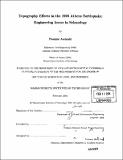| dc.contributor.advisor | Eduardo Kausel. | en_US |
| dc.contributor.author | Assimaki, Dominic, 1975- | en_US |
| dc.contributor.other | Massachusetts Institute of Technology. Dept. of Civil and Environmental Engineering. | en_US |
| dc.coverage.spatial | e-gr--- | en_US |
| dc.date.accessioned | 2006-03-24T18:14:50Z | |
| dc.date.available | 2006-03-24T18:14:50Z | |
| dc.date.copyright | 2004 | en_US |
| dc.date.issued | 2004 | en_US |
| dc.identifier.uri | http://hdl.handle.net/1721.1/30048 | |
| dc.description | Thesis (Sc. D.)--Massachusetts Institute of Technology, Dept. of Civil and Environmental Engineering, 2004. | en_US |
| dc.description | Includes bibliographical references. | en_US |
| dc.description.abstract | It is well known that irregular topography can substantially affect the amplitude and frequency characteristics of seismic motion. Macroseismic observations of destructive earthquakes often show higher damage intensity at the tops of hills, ridges and canyons than at lower elevations and on flat areas. Systematic seismic motion amplification over convex topographies has been confirmed by instrumental studies and also predicted by theoretical and numerical simulations of wave diffraction. Nonetheless, for the most part, the former have been limited to weak motion data and the later have treated topographic asperities as simple geometric irregularities on the surface of homogeneous, linearly elastic halfspaces. Despite the qualitative agreement between theory and observations on topography effects, there is still much uncertainty concerning the actual severity of amplification near topographic irregularities, inasmuch as predictive methods are still lacking on the quantitative aspects of seismic amplification near such features. Focusing of seismic rays by convex topographies does play a significant role as shown theoretically, yet it is not the only physical phenomenon involved. On the other hand, weak motion data may not be applicable to describe topography effects for strong shaking, and indeed there exist very few- if any- well documented case studies demonstrating the severity of topographic effects for strong ground motion. In this dissertation, we find that topography and local soil conditions need to be accounted for simultaneously for the prediction of site amplification factors, especially when earthquake motions are strong enough to elicit clear nonlinear soil behavior. | en_US |
| dc.description.abstract | (cont.) We examine how local stratigraphy, material heterogeneity and nonlinear soil response can alter the focusing mechanism at the vertex of cliff-type topographies, and how the free-field response is further modified on account of soil-structure interaction. By means of a case-study from the Athens 1999 earthquake, we validate the effects of local soil conditions by comparison with weak motion data, and illustrate the effects of nonlinear soil behavior and soil-structure interaction on strong motion amplification. Our finite-element, nonlinear simulations seem to explain the uneven distribution of severe damage in the community of Adàmes that borders the crest of the Kifissos river canyon at its deepest point. They also resolve in part previously unexplained discrepancies, often observed between strong amplification during actual earthquakes and moderate values predicted by simple theoretical models. Combining our findings with earlier published results, we propose a period- and space-dependent factor, referred to as Topographic Aggravation Factor (TAF), which can be used in engineering design to modify site-specific design spectra of seismic code provisions to account for topography effects. | en_US |
| dc.description.statementofresponsibility | by Dominic Assimaki. | en_US |
| dc.format.extent | 512 p. | en_US |
| dc.format.extent | 25919801 bytes | |
| dc.format.extent | 25919600 bytes | |
| dc.format.mimetype | application/pdf | |
| dc.format.mimetype | application/pdf | |
| dc.language.iso | eng | en_US |
| dc.publisher | Massachusetts Institute of Technology | en_US |
| dc.rights | M.I.T. theses are protected by copyright. They may be viewed from this source for any purpose, but reproduction or distribution in any format is prohibited without written permission. See provided URL for inquiries about permission. | en_US |
| dc.rights.uri | http://dspace.mit.edu/handle/1721.1/7582 | |
| dc.subject | Civil and Environmental Engineering. | en_US |
| dc.title | Topography effects in the 1999 Athens earthquake : engineering issues in seismology | en_US |
| dc.type | Thesis | en_US |
| dc.description.degree | Sc.D. | en_US |
| dc.contributor.department | Massachusetts Institute of Technology. Department of Civil and Environmental Engineering | |
| dc.identifier.oclc | 55590032 | en_US |
